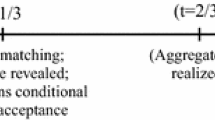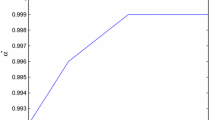Abstract
The paper studies the optimal design of clearing systems. The paper analyzes how counterparty risk should be allocated, whether traders should be fully insured against that risk, and how moral hazard affects the optimal allocation of risk. The main advantage of centralized clearing, as opposed to no or decentralized clearing, is the mutualization of risk. While mutualization fully insures idiosyncratic risk, it cannot provide insurance against aggregate risk. When the latter is significant, it is efficient that protection buyers exert effort to find robust counterparties, whose low default risk makes it possible for the clearing system to withstand aggregate shocks. When this effort is unobservable, incentive compatibility requires that protection buyers retain some exposure to counterparty risk even with centralized clearing.




Similar content being viewed by others
Notes
The G20 meeting in September 2009 chose December 2012 as the deadline for this change. It is not clear this deadline will be met.
To achieve this, the two parties can trade a Credit Default Swap, or possibly another derivative, such as a forward contract. Our optimal contracting approach enables us to consider general contract structures, without restricting attention to particular instruments.
In the first case, we analyzed why centralized clearing dominated decentralized clearing. For brevity, in the second and third cases we only consider centralized clearing. This is without loss of generality. In our optimal contracting framework, the optimal centralized mechanism dominates decentralized clearing by construction.
Ex ante, the probability that the value of the asset is good is exactly one half on average. The model with aggregate risk nests the model without aggregate risk as a particular case.
In practice, this process might involve additional intermediaries, such as the brokers of A and B. For simplicity, these are not discussed here.
For a recent paper analyzing whether centralized clearing of OTC transactions can improve welfare and economize on settlement costs, see Koeppl, Monnet, and Temzelides (2012).
This can be the case, for example, for swap deals struck on the OTC market, and then cleared through LCH.Clearnet or SwapClear. In that case, the original swap is transformed into two deals: between the swap buyer and the CCP, and between the CCP and the swap seller.
Thompson (2010) and Biais, Heider, and Hoerova (2010) also study inefficiencies associated with the default of protection sellers, but they do not model CCPs.
Thus, they consider an adverse-selection model, which contrasts with our moral-hazard setup.
In our analysis, the CCP leads to an increase in counterparty risk relative to the decentralized clearing case, because better risk-sharing undermines incentives to search for creditworthy counterparties.
We consider only one market, whereas Duffie and Zhu (2011) analyze netting efficiency in a multimarket setting. They point out that when traders intervene in different markets, having separate CCPs in different markets can lead to excessive collateral deposits.
Concavity of the objective function of the protection buyer can reflect institutional, financial or regulatory constraints, such as leverage constraints or risk-weighted capital requirements.
Stephens and Thompson (2011) also analyze a model with “good” and “bad” protection sellers. But they define good and bad types differently. In Stephens and Thompson (2011), good protection sellers invest the insurance premium in liquid but low return assets, which can be pledged to pay the insurance, while bad protection sellers invest the premium in illiquid high return assets, which cannot be pledged to pay the insurance. In contrast, in the present paper, bad protection sellers have both a higher probability of default and a lower rate of return than good protection sellers. Furthermore, in Stephens and Thompson (2011) the presence of the two types of protection sellers is associated with an adverse selection problem, while in the present paper it corresponds to a moral hazard problem.
This can be interpreted in terms of due diligence.
A richer model of the search process would have probabilities strictly between 0 and 1 to find good counterparties. The probabilities would reflect the number of available good protection sellers. While our 0–1 specification is more stylized, and hence more tractable, both specifications yield the same qualitative insights.
An important setting for which our analysis is relevant is the CDS market. In our optimal contracting approach, however, instead of specifying payoffs matching the features of a given type of contract, we allow for general transfers. For complex distributions such generality could prove untractable. For the simple distributions we assume it does not.
This aspect of our model is in line with Thompson (2010). In contrast with Thompson's assumption that the portfolio choice of the protection seller is private information, we assume the liquid holdings of the clearing agent are observable. Thus, in our analysis, in contrast with Thompson (2010), there is no moral-hazard problem associated with safe liquid holdings.
For details, see the proof of Proposition 4.
For the sake of brevity, we do not state these results formally. Their derivation is exactly as in Proposition 4. One only replaces p with (p−δ), so τ(θ, R), for example, is now given by τ(θ, R)=(Δθ)/(1+(p−δ)).
Since the link between the search effort of the protection buyer and the type of the protection seller he is matched with is one to one, it makes no difference whether the contract is contingent on effort or on protection seller type.
This underscores that, in spite of formal similarities, the setup we consider is very different from that analyzed by Holmström and Tirole (1998). In Holmström and Tirole (1998), at cost B, the agent can reduce the probability of low output. Thus, effort increases the average output in the economy. Even with risk-neutrality this can be valuable, if B is low enough. In the present model, at cost B, the agent can find a protection seller with low probability of default. But, effort does not increase the average output in the economy: the overall output of the protection sellers is exogenous and unaffected by the protection buyers’ efforts. Therefore, the effort of the protection buyers can be useful only if it increases their risk-sharing ability. However, with mutualization and no aggregate risk, full risk-sharing can be achieved even if the protection sellers are bad. Hence, effort is not optimal.
Note that, if γ=0, that is, there is no aggregate risk, condition (27) is equivalent to R≥(Δθ)/(1+p−δ) which holds under Equation (19).
The central planner could use a revelation game to elicit truthful messages from the protection buyer and the protection seller about the latter's type. For simplicity we rule this out. To micro-found this restriction one could allow for collusion between the protection buyer and the protection seller (as in Laffont and Martimort, 2000), and assume it is costly for the protection seller to be revealed bad to the central planner (for example, due to higher regulation cost and compliance burden or loss of reputation). This would preclude costless revelation. If the revelation cost is large enough, it becomes efficient for the central planner to impose a condition similar to Equation (34), precluding full insurance against counterparty risk.
In contrast, counterparty risk could be heterogeneous when good and bad protection sellers coexist. With such coexistence, the features of clearing arrangements should be adjusted to fit the counterparty risk of each protection seller.
Exchange trading of heterogeneous products would be unrealistic.
References
Acharya, V., and A. Bisin, 2010, “Counterparty Risk Externality: Centralized versus Over-the-counter Markets,” NBER Working Paper No. 17000.
Biais, B., F. Heider, and M. Hoerova, 2010, “Risk-sharing or Risk-taking? Counterparty Risk, Incentives and Margins,” ECB Working Paper No. 1413.
Carapella, F., and D. Mills, 2012, “Information Insensitive Securities: The True Benefits of Central Counterparties,” Working Paper (Federal Reserve Board).
Duffie, D., and H. Zhu, 2011, “Does a central clearing counterparty reduce counterparty risk?,” Review of Asset Pricing Studies, Vol. 1, No. 1, pp. 74–95.
Diamond, D., and P. Dybvig, 1983, “Bank Runs, Deposit Insurance and Liquidity,” Journal of Political Economy, Vol. 91, No. 3, pp. 401–419.
Ehrlich, I., and G. Becker, 1972, “Market Insurance, Self-insurance and Self-protection,” Journal of Political Economy, Vol. 80, No. 4, pp. 623–648.
Hellwig, M., 1994, “Liquidity Provision, Banking, and the Allocation of Interest Rate Risk,” European Economic Review, Vol. 38, No. 7, pp. 1363–1389.
Holmström, B., and J. Tirole, 1998, “Private and Public Supply of Liquidity,” Journal of Political Economy, Vol. 106, No. 1, pp. 1–40.
Koeppl, T., 2012, “Central Counterparty Clearing: Incentives, Market Discipline and the Cost of Collateral,” Working Paper (Queens’ University).
Koeppl, T., and C. Monnet, 2010, “The Emergence and Future of Central Counterparties,” Federal Reserve Bank of Philadelphia Working Paper No. 10–30.
Koeppl, T., C. Monnet, and T. Temzelides, 2012, “Optimal Clearing Arrangements for Financial Trades,” Journal of Financial Economics, Vol. 103, No. 1, pp. 189–203.
Laffont, J.-J., and D. Martimort, 2000, “Mechanism Design with Collusion and Correlation,” Econometrica, Vol. 68, No. (2), pp. 309–342.
Leitner, Y., 2012, “Inducing Agents to Report Hidden Trades: A Theory of An Intermediary,” Review of Finance, forthcoming.
Parlour, C.A., and U. Rajan, 2001, “Competition in Loan Contracts,” American Economic Review, Vol. 91, pp. 1311–1328.
Pirrong, C., 2011, “The Economics of Clearing in Derivatives Markets: Netting, Asymmetric Information, and the Sharing of Default Risks Through a Central Counterparty,” Working Paper (University of Houston).
Stephens, E., and J. Thompson, 2011, “CDS as Insurance: Leaky Lifeboats in Stormy Seas,” Working Paper (University of Alberta and University of Waterloo).
Thompson, J., 2010, “Counterparty Risk in Financial Contracts: Should the Insured Worry about the Insurer?,” Quarterly Journal of Economics, Vol. 125, No. 3, pp. 1195–1252.
Additional information
Supplementary Information accompanies the paper on IMF Economic Review website (http://www.palgrave.com/imfer)
*Bruno Biais holds a Ph.D. from HEC and is Professor at the Toulouse School of Economics (FBF IDEI Chair on Investment Banking and Financial Markets & CNRS). Florian Heider is a Senior Economist in the Financial Research Division at the European Central Bank. Marie Hoerova is an Economist in the Financial Research Division of the European Central Bank. The authors thank Pierre-Olivier Gourinchas (editor), Ayhan Kose (co-editor), Stijn Claessens (guest editor), Ana Fostel (IMF ARC discussant), Iman van Lelyveld (DNB discussant), Christophe Perignon, and two anonymous referees for helpful comments on earlier drafts. This paper was prepared for the Twelfth Jacques Polak Annual Research Conference on “Monetary and Macroprudential Policies” held 10–11 November 2011, in Washington, DC. Many thanks for insightful comments to participants at the IMF Twelfth Jacques Polak Annual Research Conference, the Fifth Financial Risk International Forum in Paris, the Financial Infrastructures Conference (Tilburg University/Dutch National Bank), and the European Central Bank. The views expressed do not necessarily reflect those of the European Central Bank or the Eurosystem. Biais gratefully acknowledges the support of the European Research Council, Grant 295484, Trading and Post-trading.




